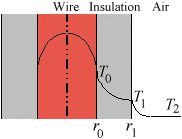An electric wire with radius
r0 of 0.50 mm is made of electrical conductivity = 5.1 x 10
7 ohm
-1 m
-1 and thermal conductivity = 380 W/(m K)]. It is insulated (see figure) to an outer radius
r1 of 1.50 mm with plastic [thermal conductivity = 0.350 W/(m K)].
 Figure.
Figure. Heating of an insulated electric wire.
The ambient air is at 38.0
oC and the coefficient from the outer insulated surface to the surrounding air is 8.500 W/(m
2 K). Determine the maximum current in amperes that can flow at steady-state in the wire without any portion of the getting heated above its maximum allowable temperature of 93.0
oC.
ANSWER:
In general, the flow is given by
Q =
DT/
Rth, where
DT is the temperature driving force (thermal potential difference). The for a cylindrical annulus is
Rth = ln (
r1/
r0)/(2
p kL) and the thermal resistance for a fluid film at a solid-fluid interface is
Rth = 1/(
hA). Here,
k is the thermal conductivity,
h is the heat transfer coefficient and
A is the surface area for convection.
The thermal resistances for the insulation and air film are in series as shown in the figure below.
 Figure.
Figure. Thermal resistance representation of insulation and air film.
Based on the above thermal resistance representation, the heat flow is
 | (1) |
where
k is the thermal conductivity of the plastic insulation.
The flow of an electric current results in some electrical getting converted to thermal energy irreversibly. The heat generation by electrical dissipation per unit volume is given by
S =
I 2/
ke where
I is the current density (in amp/m
2) and
ke is the electrical conductivity (in ohm
-1 m
-1).
The total heat generated within the wire is simply the product of
S and the volume of the wire. At steady-state, all this heat generated within the wire by electrical dissipation must leave through the wire surface and therefore the heat flow is given by
[table width="100%" align=center]<TR vAlign="center">[td noWrap align=middle]On eliminating
Q from the above two equations, the current density is
 | (3) |
On multiplying the current density by the cross-sectional area of the wire, the current is obtained from
 | (4) |
